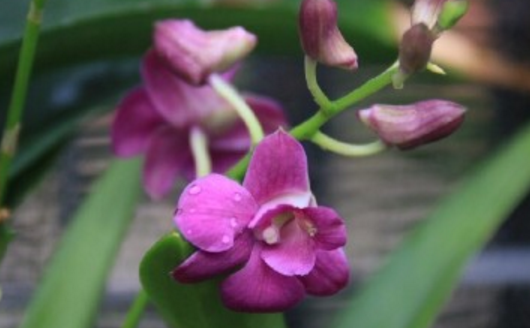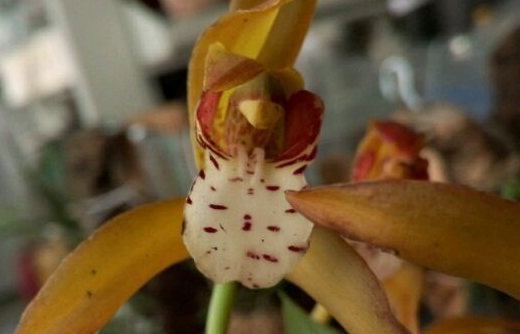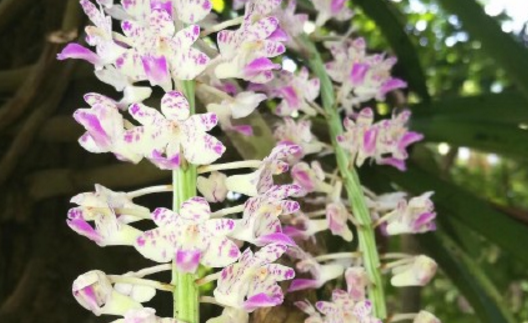How to grow Lanyako Wandailan? The difference between Qiandailan and Qiandailan? What if the leaves turn yellow?
Wandailan, also known as Wandai orchid, is a southern orchid, so how to grow Wandai orchid? The difference between Qiandailan and Qiandailan? What if the leaves turn yellow? According to the data, Wandailan has strong cold resistance, poor heat resistance, like drying and anorexia, and still grows well in high temperature 35 ℃. Cultivation needs less plant materials, in Thailand, only need to use a rope to hang the utensils under the tree, often watering, fertilization can grow.

First, how to plant Wandailan?
1. Planting environment
Soil: the roots of Wandai orchid are thicker and longer, and they are most exposed in the air, so when planting in flowerpots, we must choose soils with good water and air permeability, but rotten leaf soil and culture soil are not recommended.
Temperature: when planting, it is best to choose the temperature above 20 degrees, and the most suitable planting temperature is between 20 degrees and 30 degrees.
Humidity: humidity is very important to it, because its roots like to be exposed in the air, it needs a higher humidity, and the humidity can be maintained between 70% and 80% when planting, so it is necessary to sprinkle water around it irregularly, especially in winter. it is best to have a humidifier, after all, artificial watering can not be carried out at all times.
Moisture: although it is necessary to keep moist soil when planting, this does not mean that stagnant water can occur, otherwise it will affect its survival.
2. Methods of planting
Collect fresh seeds and rinse clean with water and sprinkle them on the culture soil, the temperature is controlled at 25 degrees, it is best to have 12 hours a day to be exposed to sunlight, fluorescent lamps can be used temporarily instead of fluorescent lamps in cloudy days, and bulbs can grow in about 2 to 3 months. then cut the bulb into pieces, wait in water to take root, and then it can be planted.
In fact, the vitality of Wandailan is very strong, and its flowers are large and gorgeous, so it is worth planting.
Second, the difference between Qiandailan and Qiandailan?
1. The varieties of Wandai orchid are different from those of Qiandailan.
Wandailan is the general name of the genus Cymbidium. There are about 60,80 species of this genus, which are widely distributed in China, India, Malaysia, the Philippines, Hawaii, New Guinea, Australia and other places. Cymbidium is produced by the cross between Cymbidium and Wandailan.
2. The morphological characteristics of Wandai orchid and Qiandai orchid are different.
Wandai orchid is a typical epiphytic orchid; its calyx is well developed, and its two lateral calyx are larger, which is the most conspicuous part of the whole flower, but its petals are smaller and its lip petals are smaller; its flower patterns are very diverse, some are reversed and twisted, some are round and flat; its flowering period is so long that a flower can even bloom for several weeks in a row.
The plant of Qiandai orchid is relatively small, and its size is only about half of that of Wandai orchid; the flowers of Qiandai orchid are colorful, and there are flowering varieties all year round, but most of them are concentrated in spring or summer and autumn; the color changes of Qiandai orchid are also very rich and varied.
Third, what if the leaves turn yellow?
1. Water yellow
It is the long-term accumulation of water in the flowerpot that is too moist, resulting in a lack of oxygen in the soil. This condition will cause a small number of roots to rot, but also lead to a decline in the ability to absorb water and the ability to absorb fertilizer. The new leaves will appear dark yellow and have no luster on the surface. The tip of the new leaf shrinks, and the branches become small and yellowish green.
Governance method
The soil should be loosened in time, the amount of water should be reduced, and the use of fertilizer should be stopped. in serious cases, the soil and plants in the basin can be taken out to dry and put back.
2. Fat yellow
It is caused by excessive fertilization, especially the yellowing of leaves caused by nitrogen fertilizer. This situation is that the new leaves are thick and glossy, the surface of the leaves is uneven, and the old leaves slowly turn yellow and fall.
The governance method is
We should stop fertilizing and increase the amount of water to desalinate nutrients.
When the fertilizer is insufficient or the plant pot is small, when the roots in the flowerpot are old and too dense, the leaves of the flower plant will be thin and yellow.
To change the basin soil, it is generally better to do it during the period from Rain Water to the Beginning of Summer.
Time: 2019-03-16 Click:
- Prev

What is the culture method of Lilium subclass Magnolia? How do you breed? What about the rotten roots?
The orchid likes the sunny and cool environment, but the high temperature does not grow well, so what is the breeding method of the orchid? How do you breed? What about the rotten roots? It is understood that the orchid should be planted in a well-ventilated environment. Sex likes yin, avoid direct sunlight, like moist, avoid dryness.
- Next

What is the breeding method of multi-flower fingernail orchid? The difference between Cymbidium and foxtail orchid? How to install the basin?
Nail orchid likes a warm and humid environment, does not like light, suitable for living in a semi-shady environment, so what is the breeding method of nail orchid? The difference between Cymbidium and foxtail orchid? How to install the basin? According to the data, the suitable temperature for the growth of nail orchid is 15-28 ℃, and the winter temperature is above 8 ℃.
Related
- Fuxing push coffee new agricultural production and marketing class: lack of small-scale processing plants
- Jujube rice field leisure farm deep ploughing Yilan for five years to create a space for organic food and play
- Nongyu Farm-A trial of organic papaya for brave women with advanced technology
- Four points for attention in the prevention and control of diseases and insect pests of edible fungi
- How to add nutrient solution to Edible Fungi
- Is there any good way to control edible fungus mites?
- Open Inoculation Technology of Edible Fungi
- Is there any clever way to use fertilizer for edible fungus in winter?
- What agents are used to kill the pathogens of edible fungi in the mushroom shed?
- Rapid drying of Edible Fungi

